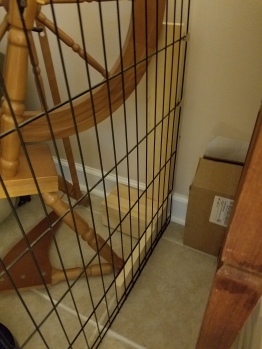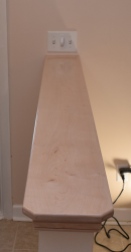I don’t always build sharpening equipment, but when I do I go overboard. With a more stable work station I can get deeper down the sharpening rabbit hole and focus on doing better work. I am trying to take sharpening from an afterthought to an everyday part of my woodworking. This post’s focus is going to be on flat backs.
It is important to have flat chisel backs and for the last inch or two of your plane irons to be flat. Pushing down on a small area gives me hand cramps after a while. I always want to cut corners in this area, but need to get better. Ideally when human frailty becomes a process issue I would advocate for robotics. I am not that rich, so a helper jig will have to do.
I started with the idea of embedding some magnets in a block of wood sized right to fit in your hand. Instead I found this magjig switchable magnet. It has a lot of force when you rotate the knob and align the magnets. I thought about woodworking a handle of some sort, but printing turned out to be a lot easier.
The magnet is be better than hands even without the printed parts, but they help spread the force over a larger area of the chisel, and makes for a better handle.

I made a gif of it in action. It holds really well and lets me put downward pressure across the chisel while controlling the back and forth motion. This works well on wider chisels, narrow ones don’t take long to flatten. Added to thingiverse.

Plane blades are a lot wider and thinner. That makes the magnet option harder. This jig I found in a popular woodworking article won’t have that issue. I started with a quite lovely short piece of maple.

I used to never make a jig out of anything but the cheapest material I could find. Now I am starting to get the idea of the jigs being tough and good looking themselves. That having been said, I made a complete hack job of this slot. It was an odd size so none of my chisels quite worked. I drilled out a little pocket so my handle bolt wouldn’t spin.
A big mushroom handle on top lets me grip with the whole hand and have a lot of control and force. The slot allows for a wide range of plane blades to be clamped.
It probably isn’t the best mirror polish the back of a plane blade has ever seen, but it is hands down the best I have ever done. Plus, it is a jack plane, so perfection isn’t exactly required.


I played around with the jig for a while before applying a finish. I made a second hole on the other side to move the handle closer to the edge. That seemed to control a little better. Adjustment there might be nice in the next version. The bolt that clamps down the blade was an issue too. I could only tighten so far before the head would spin. Sometimes the blade would want to rotate. I thinned a scrap of maple and cut another pocket. Now there is wood on metal instead of metal on metal (no chance of damaging the blade), and I can tighten to my hearts content.
Lastly a touch of tung oil made everything look gorgeous. This thing will probably be black with grinding good in a month, but for now it is gorgeous.




















 all started when I had an idea for a simple 3D print that would hold the fence segments if you screwed them to something sturdy. It seemed like a good idea, but eventually needed another iteration.
all started when I had an idea for a simple 3D print that would hold the fence segments if you screwed them to something sturdy. It seemed like a good idea, but eventually needed another iteration. The brackets looked pretty good in wood filled PLA and held the fence well. The issue I ran into was when it came to actually holding the little
The brackets looked pretty good in wood filled PLA and held the fence well. The issue I ran into was when it came to actually holding the little 




































 On to the back porch. I found polycarbonate panels that are similar to the metal ones we already have. They don’t come in the right sizes, but with careful sawing they can be made shorter. A center punch and 1/2″ drill bit put holes where you need them. They aren’t as easy to see through as normal windows, but at least some light can get in and you could tell if the shed is still there or not. Our back kitchen window has a full complement of clear shutters, and each back set of french doors has a single clear panel.
On to the back porch. I found polycarbonate panels that are similar to the metal ones we already have. They don’t come in the right sizes, but with careful sawing they can be made shorter. A center punch and 1/2″ drill bit put holes where you need them. They aren’t as easy to see through as normal windows, but at least some light can get in and you could tell if the shed is still there or not. Our back kitchen window has a full complement of clear shutters, and each back set of french doors has a single clear panel.
